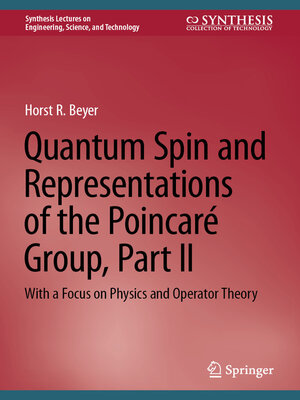Quantum Spin and Representations of the Poincaré Group, Part II
ebook ∣ With a Focus on Physics and Operator Theory · Synthesis Lectures on Engineering, Science, and Technology
By Horst R. Beyer

Sign up to save your library
With an OverDrive account, you can save your favorite libraries for at-a-glance information about availability. Find out more about OverDrive accounts.
Find this title in Libby, the library reading app by OverDrive.



Search for a digital library with this title
Title found at these libraries:
| Library Name | Distance |
|---|---|
| Loading... |
This book discusses how relativistic quantum field theories must transform under strongly continuous unitary representations of the Poincaré group. The focus is on the construction of the representations that provide the basis for the formulation of current relativistic quantum field theories of scalar fields, the Dirac field, and the electromagnetic field. Such construction is tied to the use of the methods of operator theory that also provide the basis for the formulation of quantum mechanics, up to the interpretation of the measurement process. In addition, since representation spaces of primary interest in quantum theory are infinite dimensional, the use of these methods is essential. Consequently, the book also calculates the generators of relevant strongly continuous one-parameter groups that are associated with the representations and, where appropriate, the corresponding spectrum. Part II of Quantum Spin and Representations of the Poincaré Group specifically addresses: construction of a double cover of the restricted Lorentz Group; Weyl spinors; Weyl representation of SL(2, C); an extension to a strongly continuous representation of a semi-direct product of R^4 and SL(2, C); Dirac spinors; Dirac fields; Dirac equation; Spin 1 representations of SL(2, C); Maxwell fields; and Maxwell's equations.







